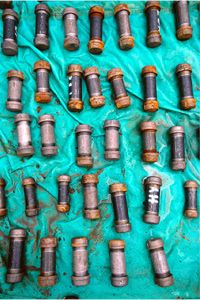Basic Bomb Components
Once bomb disposal experts have thoroughly evaluated a device, they follow "render safe" procedures to make sure an explosion doesn't harm civilians or soldiers. Ideally, they prefer to dismantle a bomb completely, separating explosives from electronics and other components, so they can analyze how it's made. This information then becomes part of an ever-growing bomb disposal knowledge base, which can help technicians on future encounters. But dismantling a device isn't always the most practical or safest solution. Sometimes, the experts opt for a controlled detonation -- the fighting-fire-with-fire approach.
Before we go further, let's get a working knowledge of bomb anatomy going. Although bombs, especially IEDs, can take many different forms, they possess four main components:
Advertisement
- The power supply is usually a battery, which supplies energy to the initiator and, in most cases, to the switch. If no power supply is present, then a mechanical switch triggers the initiator.
- The initiator causes the bomb to explode. It can take many forms, depending on the nature of the explosives. One of the most common initiators is a blasting cap, a small tube filled with a volatile substance such as mercury fulminate.
- Explosives: The main charge can be a high explosive or a deflagrating explosive. Bomb makers frequently pack ball bearings, screws or nails around the main charge to maximize damage and casualties.
- Anything that sets off the initiator can be used as a switch. Bomb makers sometimes use wireless devices, such as cell phones, key fobs or walkie-talkies. Other times, they opt for wired triggers, such as trip wires, trip plates and timers.
Dismantling a bomb requires that these different components be teased apart without causing the main charge to explode. Controlled detonation represents a different strategy. Instead of trying to prevent the device from exploding, bomb disposal teams initiate an explosion on their terms, so they can take control away from an enemy or terrorist group.
